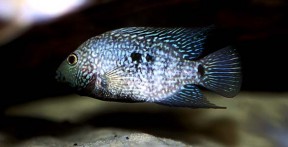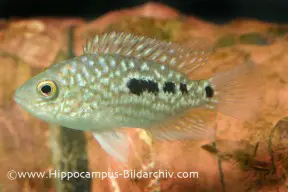Herichthys carpintis
Pearlscale Cichlid
Classification
Cichlidae
Distribution
North Mexico
Habitat
Occur in lagoons, especially at the mouth of the Panuco drainage.
Maximum Standard Length
12″
Aquarium SizeTop ↑
48″L x 18″H x 15″W (120cm x 45cm x 37.5cm) – 213 litres
Maintenance
As long as territories (rock, wood) and open space is provided in the aquarium, Carpintis aren’t too fussed. Plants rooted in the substrate will likely be uprooted as the Pearlscale Cichlid is a digger.
Water Conditions
Temperature: 75 to 79°f (24 to 26°c)
pH: 7.0
Hardness: 8 to 14°dH
Diet
Omnivore. Should accept dry foods no problem. Feed a high quality cichlid pellet as staple and vary often with frozen and livefoods. Will especially appreciate brineshrimp. Also offer regular feedings of vegetable/spirulina flakes or similar.
Behaviour and CompatibilityTop ↑
Like a lot of the central/north American large cichlids, this fish can be very territorial – especially when breeding, and sometimes downright aggressive. Small fish will be seen as food.
Sexual Dimorphism
The female Pearlscale Cichlid has black blotch on dorsal fin and is usually longer and deeper bodied than the male.
Reproduction
Carpintis is a substrate spawner. A pair will bond, then start displaying to each other – circling around, flapping tails at the others’ lateral line. If the partnership is agreed, both fish will change colour, to a startling black (rear part of the fish’s body) and white (front part of the fish’s body).
A spawning site will be cleaned, usually a bit of smooth-surfaced rock. Slate is ideal for this purpose. The female Pearlscale Cichlid will lay the eggs, then the male will move in to fertilise them. Both parents will then fan the eggs with their pelvic fins to provide oxygenated water to the eggs.
Eggs can take upto 2 days to hatch (at this point they may be moved into other designated spawning pits), and upto a week later the fry will be free swimming.
NotesTop ↑
The Pearlscale Cichlid is an extremely attractive fish, showing some gorgeous bluey green hues and reflective flecks on their flanks. They aren’t difficult to look after or breed, but be careful when choosing tankmates. The only problem with spawning is that the male may become aggressive towards the female – it is certainly wise to have a tank divider, just in case.
Look out for Pearlscale Cichlids labelled as Texas Cichlids, as it is a misleading common name that is often given to Herichthys Carpintis – though a totally different species to the fish we know as the Texas Cichlid (Herichthys cyanoguttatus). It is often labelled as the Green Texas Cichlid.
Pearscale Cichlids require large aquaria with good filtration, but are a relatively easy to keep fish. A good fish for fishkeepers wanting to get into keeping big central/north American cichlids.




March 4th, 2019 at 1:30 am
I actually just came across & bought one the other day… My only regret is that I didn’t get 3! Absolute Gorgeous Cichlid…